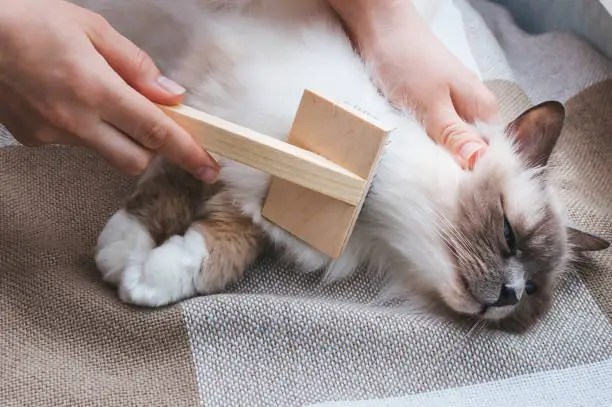With their long, lush coats and doll-like faces, Persian cats seem like the perfect feline companions. But many prospective owners wonder – are Persian cats actually hypoallergenic? Can people with allergies still enjoy their company? Understanding the links between this breed, allergens, and allergy levels provides the answers.
Are Persian Cats Hypoallergenic?
Are Persian Cats Hypoallergenic? Check out whether color variations like white Persians may be hypoallergenic. Get grooming tips to reduce reactions.
Persian cat allergies can be a serious problem for pet owners. This article explores the truth to our question are Persian cats hypoallergenic?
What Makes Cats Cause Allergies?
Allergies to cats are triggered not by their fur, but by Fel D1, a protein in their saliva, skin and urine. When grooming, cats spread this allergen throughout their coat. As they shed, Fel D1-covered hairs and dander become airborne. Allergy sufferers react when inhaling or touching these particles.

Persian cats produce less Fel D1 than other breeds, but they still create some. Their long coats also trap more dander and allergens close to their bodies, preventing widespread dispersal. These factors make Persians less likely to cause allergic reactions than more shedding-prone cats. But no cat is 100% non-allergenic.
Are Some Persian Cats More Hypoallergenic Than Others?
Persian cat allergies can be from mild to extreme levels. Within the Persian breed, some colorations and bloodlines seem less allergy-provoking:
- White Persians: Lack the dark pigment associated with higher Fel D1 production. White coats also make dander more visible for easier grooming removal.
- Chinchilla Persians: Their translucent silver-tipped fur may retain less allergenic than deeply pigmented hairs. Hybrid vigor from their Siamese ancestry may also reduce shedding.
- Himalayas: As hybrids between Persians and Siamese cats, they can inherit lower allergen levels from their Siamese side. Their seal point coats also lessen visible dander.
- Shorthairs: With less coat length, shed hairs transport fewer allergens. Their shorter topcoat also reduces the “billowing” effect of long fur when a cat jumps or plays.
While your individual reaction can vary, these Persian types statistically cause fewer allergic issues for many people. Ethical breeders can provide guidance on hypoallergenic bloodlines.
Tips to Reduce Allergens in Persian Cat Allergies
Are Persian Cats Hypoallergenic? While no cat is non-allergenic, Persian owners can take steps to minimize reactions:
- Brush frequently with a stainless steel comb to remove loose hair and dander before it spreads.
- Bathe your Persian every 1-2 weeks to wash away saliva allergens coating their fur. Use a mild, cat-safe shampoo.
- Vacuum twice a week with a HEPA filter vacuum to remove allergens from carpets, couches and cat beds.
- Feed a high quality diet with omega fatty acids. This supports skin and coat health to reduce shedding and dander production.
- Use an air purifier with a HEPA filter to remove airborne allergens circulating in your home.
- Limit your Persian to one room so their allergens remain confined, rather than spreading house-wide.

With diligence, Persian cat owners can enjoy close time with their gorgeous kitties while controlling allergy triggers. Medications can also help alleviate symptoms during cuddle sessions.
Are Female Persian Cats Less Allergenic Than Males?
Many cat lovers believe female cats cause fewer allergies than males. Persian cat allergies occur due to various reasons. This is linked to perceptions that:
- Male cats are larger, so produce more allergens.
- Male cats roam more, spreading dander further in the home and outdoors.
- Males are more aggressive groomers, coating their fur in more saliva allergens.
- Testosterone increases sebum production, making male coats greasier and “dustier.”

However, studies show mixed evidence on whether sex actually impacts allergen levels in cats. While neutering your Persian may reduce roaming, aggression, and hormone-related skin changes, the cat’s gender itself is unlikely to affect allergies. Both male and female Persians produce allergens.
Research has been very helpful in understanding are Persian cats hypoallergenic?
Can You Safely Acclimate to a Persian Cat?
For those with mild Persian cat allergies, carefully monitored exposure to a Persian kitten may allow safe acclimation. Follow these tips:
- Initially interact for just 1-2 hours at a time in a single room with good air circulation.
- Take an antihistamine 30 minutes before interactions to control symptoms.
- Wear a N95 mask and wash hands frequently when handling the kitten.
- Vacuum diligently and limit fabric furnishings the cat can access.
- Slowly increase exposure time while monitoring your reactions. Stop if symptoms worsen.
With limited, controlled contact, some people build tolerance to specific cats. But severe allergy sufferers may react to even minimal exposure. Consult an allergist to determine if acclimation is an option for you.
Are Other Cat Breeds More Hypoallergenic Than Persians?
While less allergy-provoking than many breeds, Persian cats are not the most hypoallergenic feline option. Cat breeds believed to be better choices for allergy sufferers include:
- Balinese – A long-haired Siamese hybrid producing less Fel D1.
- Siberian – Naturally produces lower Fel D1 levels. Thick triple coat also traps dander.
- Sphynx – Lack of fur means no fur allergens. But skin, saliva and urine allergens remain.
- Bengal – Naturally exfoliates skin and saliva allergens off short, sleek coat.
- Cornish Rex – Sheds only fine down, not allergy-causing fur. Low dander production.
- Oriental Shorthair – Also called a “lazy man’s Siamese,” their short coats shed less.
- Devon Rex – Light shedding, low-dander curly coat. Ear wax production can be high, however.
- Burmese – Produces less Fel-D1 than most breeds, despite a short single coat.
Always spend time with individual cats of a prospective breed to see if you react before committing to ownership. Finding the right low-allergen cat for your situation requires research and diligent breeder screening.
Should You Shave Your Persian Cat for Allergies?
Shaving a Persian cat is NOT recommended for controlling diseases related to Persian cat allergies. While it may seem beneficial to remove the long fur holding allergens, shaving creates problems:
- – Cats rely on their coats for temperature regulation, protection, and skin health. Shaving leaves them vulnerable.
- – Newly growing stubble after shaving is stiff, sharp and highly irritating. It “dusts” into the environment more than longer fur.
- – Stress from shaving can increase shedding and dander production.
- – Skin abrasions from shaving become infected easily.
- – Cats can develop post-shaving alopecia where new hair fails to regrow properly in previously shaved areas.
The risks of shaving outweigh any potential allergy benefits. Regular brushing and bathing to remove allergens from an intact coat is safer for your Persian’s health.
Are Allergy Shots Effective for Persian Cat Owners?
Allergy shots, also called immunotherapy, can dramatically reduce allergic reactions to cats through gradual exposure. Here’s how this process works:
- Allergy testing identifies specific allergens affecting you, which may include cat dander and saliva proteins.
- Custom allergy serum is formulated using tiny amounts of your allergen triggers.
- This serum is injected on a regular schedule, starting with very low concentrations.
- Dosages gradually increase over 3-5 years, allowing your immune system to build tolerance.
- Once maximum dosing is reached, allergy symptoms are reduced long-term.
Allergy shots take commitment, but can successfully allow enjoyment of cats like Persians with minimal suffering. Oral or sublingual allergy drops provide a less invasive immunotherapy option. Ask your allergist if these treatments could help you own your dream hypoallergenic cat breed.
Summing Up
It can be inferred that pet owners are too keen to learn about all allergic conditions of cats. Persian cat allergies are also a critical problem for any person who love the pets specifically cats. The findings of this article helps to easily understand Persian Cat Allergies and their solutions.

